There are in this collection a number of distinct works which are linked by shared formal schemes and common symbolic content. Each is composed with a male, nude figure which is shown in a crouching position. The gesture is so intense and enveloping that the figure is seen tightly wrapped around itself to the extent of being completely shut in. The figures are characterized by these traits; so deeply imprinted are they by them that they draw attention as a closely-knit category. These productions exemplify sculpture conceived as monolithic entities; indeed, they return out considerations to the age-old but still valid task of defining sculpture in terms of the solid block or the compact hard volume. In pursuing these goals, sculptors not only project formal postulates in their productions, but also statements concerning the nature of human existence.
These are not new or unexpected revelations when matched with Eng Teng's thoughts and art. His definitions of sculpture and the symbolic distinction of this art conform to the parameters mentioned above. Sculpture, he has said again and again, has to do with "form, form in space, and of course form in relation to space and space as a positive element, an active element; sometimes you have a grouping of forms; most often it is a single form on its own. I have been told that I am producing objects, objects in space, which makes it all sound so old and ancient. But I don't mind, because I am enjoying what I am doing". (6 Dialogues, p. 45.) The making of distinct, discreet, "objects", as he calls them, has a symbolic purpose, which leads to the content of the work. In weighing this issue Eng Teng declares his intention forthrightly; "I will continue to explore and interpret life and have faith in humanity". (Conversation, p. 171.) This study has brought into relief a range of issues which signal his readings of the human condition; in transforming them into sculptural works, Eng Teng demonstrates that "faith in humanity" which he cherishes so dearly.
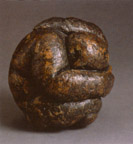
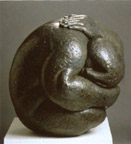 The figures which are pressed into assuming crouching positions signal extreme states of anxiety or fear. In adopting such gestures, in doubling upon themselves, these figures declare unwillingness or inability to deal with the world. The only recourse appears to be to shut the world out and shut themselves in. Fear I, 1978 (Fig. 150) shows a figure seated on its haunches with the legs tucked in; the head is lowered, held close to the chest with the right arm cradling it. The left arm is placed on its back, pulling the posterior portion forward. In Fright, 1979 (Fig. 151) the figure is presented lying on its side; the head appears into view from beneath massive arms that curt around the torso and protectively encircle the head. The legs are interlocked; only the left is visible as the right is enmeshed in the overlapping units of the remainder of the figure.
The figures which are pressed into assuming crouching positions signal extreme states of anxiety or fear. In adopting such gestures, in doubling upon themselves, these figures declare unwillingness or inability to deal with the world. The only recourse appears to be to shut the world out and shut themselves in. Fear I, 1978 (Fig. 150) shows a figure seated on its haunches with the legs tucked in; the head is lowered, held close to the chest with the right arm cradling it. The left arm is placed on its back, pulling the posterior portion forward. In Fright, 1979 (Fig. 151) the figure is presented lying on its side; the head appears into view from beneath massive arms that curt around the torso and protectively encircle the head. The legs are interlocked; only the left is visible as the right is enmeshed in the overlapping units of the remainder of the figure.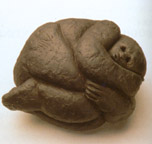 Fear II, 1978 (Fig. 152) has been developed from the maquette illustrated in Fig. 150. In the process of translating the study, Eng Teng has enhanced the articulation of depth and surface connections. This is demonstrated in the delineation of the left elbow, where the bend is registered as a folded, curving plane thrown into high relief. The spatial prominence gained by this device affects the design of the entire left arm. The shoulder captures light which is distributed over the upper arm; the eye follows this passage along continuously curved planes which point to the presence of powerful internal and external volumes. These are hallmarks consolidating highly developed concepts of and capacity to compose three dimensional forms and schemes.
Fear II, 1978 (Fig. 152) has been developed from the maquette illustrated in Fig. 150. In the process of translating the study, Eng Teng has enhanced the articulation of depth and surface connections. This is demonstrated in the delineation of the left elbow, where the bend is registered as a folded, curving plane thrown into high relief. The spatial prominence gained by this device affects the design of the entire left arm. The shoulder captures light which is distributed over the upper arm; the eye follows this passage along continuously curved planes which point to the presence of powerful internal and external volumes. These are hallmarks consolidating highly developed concepts of and capacity to compose three dimensional forms and schemes.
 Pancake, 1980 (Fig. 153) marks the most expansive treatment of the crouching figure; as in Fright, it is shown lying on its side and placed on the floor, thereby presenting the viewer with a comprehensive and commanding spectacle of its formal constitution and symbolic tenor. The scheme is shown in considerable detail; not only is it possible to discern the way in which the body is positioned, the limbs entwined and interlocked, it is also feasible to gain insights into the formal ordering of the composition. The figure shields its eyes from direct contact with the spectator; the mouth is opened as if issuing a low, long cry. The legs are curled and bound tightly to the body by the right arm, The arrangement of the limbs, body and head can be seen also in purely formal terms; they appeal as units of differing shapes and dimensions which jostle with one another. Deeply gouged, recessed grooves separate the units. The composition may also be interpreted as a mosaic of irregular formal units realized in high relief. The condition of fear or anxiety is such that the figure is threatened with disintegration. In this regard, the crouching figures invite comparison with compositions dealing with figures expressing distress. In considering them comparatively, an important difference surfaces. Whereas in schemes dramatising states of distress the figures are seen struggling against prevailing circumstances, in depictions of crouching figures the protagonists appear as acquiescent, defensive and withdrawn. Wai Hon offers a spirited interpretation of the iconography of these works; he remarks:
Pancake, 1980 (Fig. 153) marks the most expansive treatment of the crouching figure; as in Fright, it is shown lying on its side and placed on the floor, thereby presenting the viewer with a comprehensive and commanding spectacle of its formal constitution and symbolic tenor. The scheme is shown in considerable detail; not only is it possible to discern the way in which the body is positioned, the limbs entwined and interlocked, it is also feasible to gain insights into the formal ordering of the composition. The figure shields its eyes from direct contact with the spectator; the mouth is opened as if issuing a low, long cry. The legs are curled and bound tightly to the body by the right arm, The arrangement of the limbs, body and head can be seen also in purely formal terms; they appeal as units of differing shapes and dimensions which jostle with one another. Deeply gouged, recessed grooves separate the units. The composition may also be interpreted as a mosaic of irregular formal units realized in high relief. The condition of fear or anxiety is such that the figure is threatened with disintegration. In this regard, the crouching figures invite comparison with compositions dealing with figures expressing distress. In considering them comparatively, an important difference surfaces. Whereas in schemes dramatising states of distress the figures are seen struggling against prevailing circumstances, in depictions of crouching figures the protagonists appear as acquiescent, defensive and withdrawn. Wai Hon offers a spirited interpretation of the iconography of these works; he remarks:
Figures are huddled, singly or in groups, cringing in abject terror and waiting. Waiting for what? From a mass of blubbery fat and muscles, the terrified figure is compressed and, at one stage, reduced to a pancake.(Mankind as Jigsaw, p. 6.)
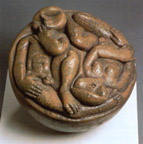
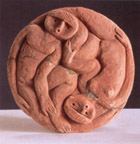 The formal possibilities in schemes with the crouching figure give rise to compositions with other, expanded iconographic meanings. Insights into these prospects can be gained by examining a drawing in which the representation of a figure set within a sphere is explored. Titled Studies for Child in a Sphere, c. 1978 (Fig. 154) it features a number of sketches; in each a figure is seen seated in a crouched position, and in one instance lying on its back and assuming a curled posture; each is framed by a circle. These may be regarded as nuclear concepts leading to the compositions discussed above. They may also be the wellsprings for compositions such as Adam and Eve II, 1988 (Fig. 155) and Yin Yang, 1986-87 (Fig. 157).
The formal possibilities in schemes with the crouching figure give rise to compositions with other, expanded iconographic meanings. Insights into these prospects can be gained by examining a drawing in which the representation of a figure set within a sphere is explored. Titled Studies for Child in a Sphere, c. 1978 (Fig. 154) it features a number of sketches; in each a figure is seen seated in a crouched position, and in one instance lying on its back and assuming a curled posture; each is framed by a circle. These may be regarded as nuclear concepts leading to the compositions discussed above. They may also be the wellsprings for compositions such as Adam and Eve II, 1988 (Fig. 155) and Yin Yang, 1986-87 (Fig. 157).

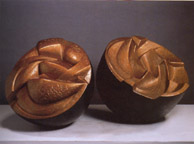 Tendencies towards realising these aims have already been observed in discussing the work titled Pancake. In the case of the former, which is preceded by a maquette bearing the same title (Fig. 156), the two figures are arranged in a compact design on the surface of a sphere which is a mobile. In the latter, the figure has assumed a different design; representationality has given way to an organisation of formal units which have been derived from the crouching figure.
Tendencies towards realising these aims have already been observed in discussing the work titled Pancake. In the case of the former, which is preceded by a maquette bearing the same title (Fig. 156), the two figures are arranged in a compact design on the surface of a sphere which is a mobile. In the latter, the figure has assumed a different design; representationality has given way to an organisation of formal units which have been derived from the crouching figure.
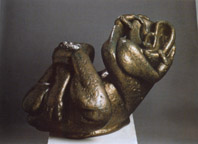 The crouching figure compositions are also hospitable towards accommodating and absorbing other figurative schemes; in fusing such categories, dynamic, syncretic forms are created, capable of conveying symbolic meanings powerfully. Prodigal Son, 1980 (Fig.158) represents a synthesis of the figure aligned along a curve and the crouching figure. The writhing figure, which is continually transforming itself while in the throes of living out excruciatingly agonising states, is one of the most compelling productions in this collection.
The crouching figure compositions are also hospitable towards accommodating and absorbing other figurative schemes; in fusing such categories, dynamic, syncretic forms are created, capable of conveying symbolic meanings powerfully. Prodigal Son, 1980 (Fig.158) represents a synthesis of the figure aligned along a curve and the crouching figure. The writhing figure, which is continually transforming itself while in the throes of living out excruciatingly agonising states, is one of the most compelling productions in this collection.

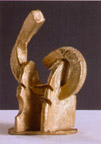 In dealing with Eng Teng's sculptural practice, this study has focused on the figure, examining the principal themes with a view towards explicating formal design and symbolic meaning. Such a focus is not an expression of my partiality but one which springs from scrutinising the range of compositions in this collection in which the figure is dominant. Even as Eng Teng's preoccupations are largely thematised by the figure, he is not indifferent to other involvements. From time to time he explores the realm of pure formal properties; in such enterprises, relationships between sculpture as a compact volume and space assume markedly different demonstrations.
In dealing with Eng Teng's sculptural practice, this study has focused on the figure, examining the principal themes with a view towards explicating formal design and symbolic meaning. Such a focus is not an expression of my partiality but one which springs from scrutinising the range of compositions in this collection in which the figure is dominant. Even as Eng Teng's preoccupations are largely thematised by the figure, he is not indifferent to other involvements. From time to time he explores the realm of pure formal properties; in such enterprises, relationships between sculpture as a compact volume and space assume markedly different demonstrations.
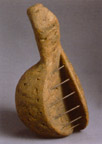 For instance, in Affinity III and IV, 1990 (Fig. 159 and 160), which were developed for a work commissioned by the Malayan Banking Berhad, Singapore (Maybank), the material components are delicately interwoven in space, and also with space as a formal element. That is to say, the twisting element encompasses space within its curvatures, even as space brushes along its exterior surfaces. In a work titled simply Form, 1990 (Fig.161), the mass has been opened up; wires span the intervening space, bridging two separated planes. Space has an interior dimension; in this work too, the medium of drawing is projected into the three-dimensional sphere. This dramatic transformation is made tangible by the use of copper wires which can be read as lines in space.
For instance, in Affinity III and IV, 1990 (Fig. 159 and 160), which were developed for a work commissioned by the Malayan Banking Berhad, Singapore (Maybank), the material components are delicately interwoven in space, and also with space as a formal element. That is to say, the twisting element encompasses space within its curvatures, even as space brushes along its exterior surfaces. In a work titled simply Form, 1990 (Fig.161), the mass has been opened up; wires span the intervening space, bridging two separated planes. Space has an interior dimension; in this work too, the medium of drawing is projected into the three-dimensional sphere. This dramatic transformation is made tangible by the use of copper wires which can be read as lines in space.
Constance Sheares characterises Eng Teng's sculptural practice in terms of oscillations between "the organic and biomorphic" on the one hand, and "the linear and geometric" on the other; in the former, the ensuing works display "solid volumes" while the pursuit of the latter leads "to a variety of forms interpenetrated by space" (Poetic Metaphors: Sculptures of Ng Eng Teng). This is, undoubtedly, a useful guide for clarifying aims fuelling Eng Teng's thoughts and works; what needs to be added is that while compositions can be distinguished from one another along such a binary scheme, there also are productions which synthesise, fuse, concepts inherent in each category.
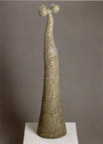

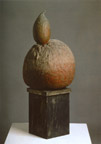 Be that as it may, this study concludes by briefly regarding works classified as "biomorphic". Timid Dancer, 1990 (Fig.162) and Plump Dancer, 1990 (Fig.163) are exemplary sculptures in which primary, organic shapes are employed imaginatively, creatively, to produce evocative forms. While the titles clearly signal figurative iconographies, these works do not strictly conform to figurative schemes.
They are made up by combining biomorphic shapes with aspects of the human figure. Consequently, interpretations of form and meaning will have to be constructed on ambivalent grounds, Compositions such as these have their ancestry in a production titled, perhaps significantly, The Beginning, 1967 (Fig. 164)!
Be that as it may, this study concludes by briefly regarding works classified as "biomorphic". Timid Dancer, 1990 (Fig.162) and Plump Dancer, 1990 (Fig.163) are exemplary sculptures in which primary, organic shapes are employed imaginatively, creatively, to produce evocative forms. While the titles clearly signal figurative iconographies, these works do not strictly conform to figurative schemes.
They are made up by combining biomorphic shapes with aspects of the human figure. Consequently, interpretations of form and meaning will have to be constructed on ambivalent grounds, Compositions such as these have their ancestry in a production titled, perhaps significantly, The Beginning, 1967 (Fig. 164)!
Sabapathy, T.K., '6 Dialogues' in Conversation with Sabapathy, T.K., Sculpture in Singapore, National Museum Art Gallery, Singapore, 1991.
Sheares, C., 'Mankind as Jigsaw' in Poetic Metaphors. Sculpture. ng eng teng, Singapore, 1991.
Last updated: 11 January 2001